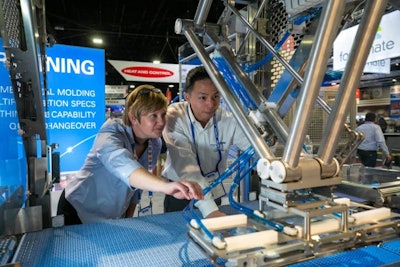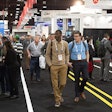
The 2022 International Production & Processing Expo (IPPE) in Atlanta showcased the newest poultry technologies, offered colleagues a chance to reunite and spoke to the issues challenging the broiler industry in the U.S. and around the world.
Back on track
The on-going COIVD-19 pandemic continues to drive down interest in live events but the world is slowly moving forward and business is adapting to the new normal. At another event I attended, the 2022 NPFDA Annual Convention and Showcase in Atlanta, I received a memento reading “Back on Track” reflecting the sentiment of the event and its organizers.
Given the gloom surrounding yet another COVID-19 variant and the fluid nature of the health and business situations, I was pleasantly surprised with the attendance of the events in Atlanta. It was not as busy as it was before the pandemic, but business was done, conversations were more personal and the event successfully resumed after the 2021 cancellation.
Automation
The global COVID-19 situation underscores the serious needs of the poultry industry. The pandemic thinned the U.S. employment pool and depressed the economy, but demand is normalizing for chicken.
At the show, I saw the leading processing machinery companies displaying labor saving devices. This is a constant. Chicken is a high tech industry with a perpetual need to shrink its expenses, reduce its exposure to the oft-unfavorable labor market and increase carcass yield.
Representatives I spoke to told me demand for value-added and further-processed products – specifically, chicken nuggets, strips, tenders and breast fillets – is growing and everyone is interested in devices to meet that demand. Moreover, demand for the latest devices is high. Some of the machines on the show floor were already sold and were headed for the plant after IPPE.
I also noticed some companies with strong presence in other animal species moving into the chicken space as they recognize the strength of the market. The U.S. was slow to automate historically, but now may be a tipping point for the country. The industry has the money to spend on these devices and recognizes the immediate value they can create.
Food safety rules
I am fortunate and spoke with many of our readers, clients and friends during the week. The biggest concern was the lack of certainty surrounding the U.S. Department of Agriculture’s Food Safety and Inspection Service’s proposal to completely overhaul the way it looks at Salmonella.
If there is anything more agitating that a new rule, it is a new, unknown rule that is certainly coming at some undefined time in the future.
One thing is certain: There will be an increased emphasis on pre-harvest Salmonella control. Look for pre-harvest interventions to become more important for the industry – and those selling to the industry – in the near future as the new rules become more apparent.
















